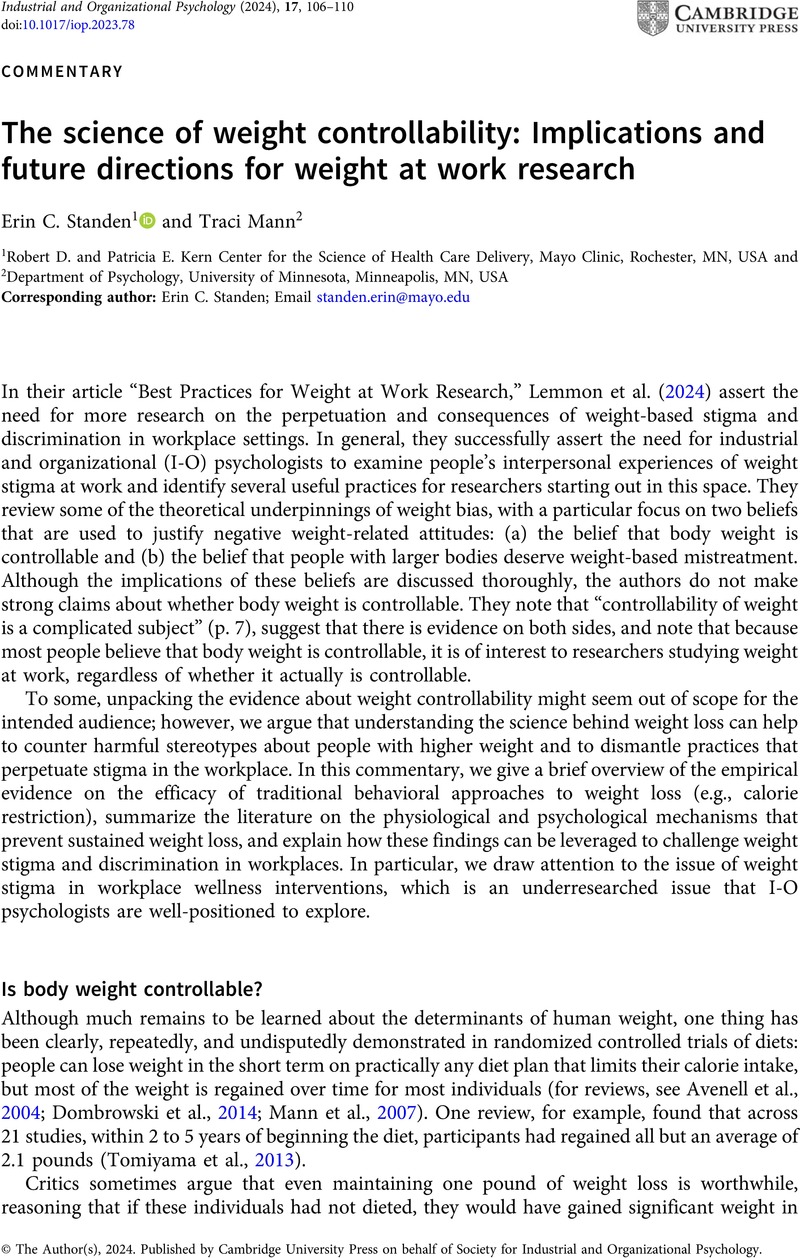No CrossRef data available.
Article contents
The science of weight controllability: Implications and future directions for weight at work research
Published online by Cambridge University Press: 07 March 2024
Abstract
An abstract is not available for this content so a preview has been provided. Please use the Get access link above for information on how to access this content.

- Type
- Commentaries
- Information
- Copyright
- © The Author(s), 2024. Published by Cambridge University Press on behalf of Society for Industrial and Organizational Psychology
References
Avenell, A., Broom, J., Brown, T. J., Poobalan, A., Aucott, L., Stearns, S. C., Smith, W. C. S., Jung, R. T., Campbell, M. K., & Grant, A. M. (2004). Systematic review of the long-term effects and economic consequences of treatments for obesity and implications for health improvement. Health Technology Assessment, 8(21), 1–182. https://doi.org/10.3310/HTA8210.Google Scholar
Bellicha, A., van Baak, M. A., Battista, F., Beaulieu, K., Blundell, J. E., Busetto, L., Carraça, E. V., Dicker, D.,
Encantado, J., Ermolao, A., Farpour-Lambert, N., Pramono, A., Woodward, E., & Oppert, J. M. (2021). Effect of exercise training on weight loss, body composition changes, and weight maintenance in adults with overweight or obesity: An overview of 12 systematic reviews and 149 studies. Obesity Reviews, 22
(S4), e13256. https://doi.org/10.1111/obr.13256.Google Scholar
Curioni, C., & Lourenço, P. (2005). Long-term weight loss after diet and exercise: a systematic review. International Journal of Obesity, 29, 1168–1174.Google Scholar
Dombrowski, S. U., Knittle, K., Avenell, A., Araújo-Soares, V., & Sniehotta, F. F. (2014). Long term maintenance of weight loss with non-surgical interventions in obese adults: Systematic review and meta-analyses of randomised controlled trials. BMJ, 348, g2646. https://doi.org/10.1136/bmj.g2646.Google Scholar
Emery, R. L., & Levine, M. D. (2017). Questionnaire and behavioral task measures of impulsivity are differentially associated with body mass index: A comprehensive meta-analysis. Psychological Bulletin, 143
(8), 868–902. https://doi.org/10.1037/BUL0000105.Google Scholar
Fothergill, E., Guo, J., Howard, L., Kerns, J. C., Knuth, N. D., Brychta, R., Chen, K. Y., Skarulis, M. C., Walter, M., Walter, P. J., & Hall, K. D. (2016). Persistent metabolic adaptation 6 years after, The Biggest Loser, competition. Obesity, 24
(8), 1612–1619. https://doi.org/10.1002/OBY.21538.Google Scholar
Horwitz, J. R., Kelly, B. D., & DiNardo, J. E. (2017). Wellness incentives in the workplace: Cost savings through cost shifting to unhealthy workers. Health Affairs, 32
(3), 468–476. https://doi.org/10.1377/HLTHAFF.2012.0683.Google Scholar
Hunger, J. M., Smith, J. P., & Tomiyama, A. J. (2020). An evidence-based rationale for adopting weight-inclusive health policy. Social Issues and Policy Review, 14
(1), 73–107. https://doi.org/10.1111/SIPR.12062.Google Scholar
Johansson, K., Neovius, M., & Hemmingsson, E. (2014). Effects of anti-obesity drugs, diet, and exercise on weight-loss maintenance after a very-low-calorie diet or low-calorie diet: A systematic review and meta-analysis of randomized controlled trials. American Journal of Clinical Nutrition, 99
(1), 14. https://doi.org/10.3945/AJCN.113.070052.Google Scholar
Keys, A., Brožek, J., Henschel, A., Mickelsen, O., & Taylor, H. L. (1950). The biology of human starvation. University of Minnesota Press.Google Scholar
Leibel, R. L., Rosenbaum, M., & Hirsch, J. (1995). Changes in energy expenditure resulting from altered body weight.
New England Journal of Medicine, 332
(10), 621–628. https://doi.org/10.1056/NEJM199503093321001.Google Scholar
Lemmon, G., Jensen, J. M., & Kuljanin, G. (2024). Best practices for weight at work research. Industrial and Organizational Psychology, 17(1), 85–105. https://doi.org/10.1017/IOP.2023.50.Google Scholar
Lewis, A., Khanna, V., & Montrose, S. (2015). Employers should disband employee weight control programs. American Journal of Managed Care, 21
(2), e91–e94.Google Scholar
Maclean, P. S., Bergouignan, A., Cornier, M.-A., & Jackman, M. R. (2011). Biology’s response to dieting: The impetus for weight regain. American Journal of Physiology Regulatory, Integrative, and Comparative Physiology, 301
(3), R581–600. https://doi.org/10.1152/ajpregu.00755.2010.Google Scholar
Major, B., Hunger, J. M., Bunyan, D. P., & Miller, C. T. (2014). The ironic effects of weight stigma. Journal of Experimental Social Psychology, 51, 74–80. https://doi.org/10.1016/j.jesp.2013.11.009.Google Scholar
Mann, T., Tomiyama, A. J., Westling, E., Lew, A.-M., Samuels, B., & Chatman, J. (2007). Medicare’s search for effective obesity treatments: diets are not the answer. American Psychologist, 62
(3), 220–233. https://doi.org/10.1037/0003-066X.62.3.220.Google Scholar
Martin, C. B., Herrick, K. A., Sarafrazi, N., & Ogden, C. L. (2018). Attempts to lose weight among adults in the United States, 2013-2016. National Center for Health Statistics.Google Scholar
Mattke, S., Schnyer, C., & Busum, K. R. Van (2013). A review of the U.S. workplace wellness market. Rand Health Quarterly, 2
(4), 7.Google Scholar
Stice, E., Burger, K., & Yokum, S. (2013). Caloric deprivation increases responsivity of attention and reward brain regions to intake, anticipated intake, and images of palatable foods. NeuroImage, 67, 322–330. https://doi.org/10.1016/j.neuroimage.2012.11.028.Google Scholar
Swift, D. L., Johannsen, N. M., Lavie, C. J., Earnest, C. P., & Church, T. S. (2014). The role of exercise and physical activity in weight loss and maintenance. Progress in Cardiovascular Diseases, 56
(4), 441. https://doi.org/10.1016/J.PCAD.2013.09.012.Google Scholar
Täuber, S., Mulder, L. B., & Flint, S. W. (2018). The impact of workplace health promotion programs emphasizing individual responsibility on weight stigma and discrimination. Frontiers in Psychology, 9, 414476. https://doi.org/10.3389/FPSYG.2018.02206/BIBTEX.Google Scholar
Tomiyama, A. J., Ahlstrom, B., & Mann, T. (2013). Long-term effects of dieting: Is weight loss related to health? Social and Personality Psychology Compass, 7
(12), 861–877. https://doi.org/10.1111/spc3.12076.Google Scholar
Vartanian, L. R., Pinkus, R. T., & Smyth, J. M. (2018). Experiences of weight stigma in everyday life: Implications for health motivation. Stigma and Health, 3
(2), 85–92. https://doi.org/10.1037/sah0000077.Google Scholar
Warburton, D. E. R., & Bredin, S. S. D. (2017). Health benefits of physical activity: a systematic review of current systematic reviews. Current Opinion in Cardiology, 32
(5), 541–556. https://doi.org/10.1097/HCO.0000000000000437.Google Scholar




